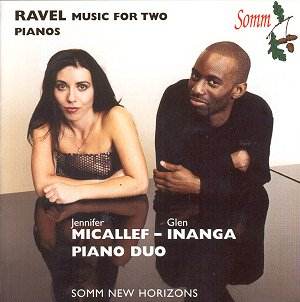Jennifer Micallef and Glen Inanga have been playing
together as a piano duo since 1994. They were both students at the Royal
Academy of Music in London, and since then have won numerous prizes
and given concerts all over Europe, with others planned worldwide. Listening
to them here I can well imagine the thrilling effect they must have
on a live audience.
A glance at the list of works shows that almost all
of the music on this disc exists also in orchestral versions. In some
cases the two-piano arrangement was made after the orchestral work was
completed, in others the two-piano version came first. Leaving aside
the quality of the performances here, how many of us will want to listen
to these pieces in their two-piano form? We may enjoy playing Beethoven
symphonies in four-hand arrangements, but would we go to a concert to
hear them? And Ravel, of course, was a master of orchestration. Well,
the answer to the question, as is often the case, is not at all clear.
The disc opens with the ravishing Introduction and
Allegro, and so perfectly is this piece conceived in its original
form that I expected it to be one of the works which would suffer most
from a lack of instrumental colour. But I was surprised how well it
works, and how little I missed the other instruments. The two-piano
arrangement is by Ravel himself, and one piano plays the harp part and
the other the rest. The players give a most sensitive performance here,
alive to every change of mood, wistful and touching in the opening pages,
scintillating at the end. Nobody would be disappointed by it.
Continuing with the pieces in the order in which they
appear on the disc, we pass to the Rapsodie espagnole, which
is listed on the back cover as the "original version for two pianos".
This, as Robert Matthew-Walkerís booklet notes make clear, is wrong.
Only the third movement, Habañera, was originally a two-piano
piece, and Ravel inserted an orchestrated version of it into his Rapsodie
espagnole. According to Francis Poulenc, writing in 1963, Ravel
was unhappy with the orchestral version of this movement, but those
who know the Rapsodie in its orchestral form will find, I think,
that this is one of those works where the wonderful range of
colour, so subtle, so evocative, which the composer draws out of the
orchestra, is cruelly lacking. Nothing can take away, however, the virtuosity
and conviction of the two players in this performance which culminates
in a breathtaking final Feria.
Entre cloches, as its title suggests, is composed
largely of bell sounds, either loud and insistent, as at the opening,
or gentler and more distant later and at the end. Itís an affecting
piece which was first published together with the Habañera
previously discussed. Itís certainly worth hearing by Ravel admirers
and completists.
Ma mère líoye can seem less sophisticated
than it really is, especially given that long passages of it are quite
easy from a technical point of view. The Micallef/Inanga duo give a
performance in which tempi are on the rapid side and pedalling is limited.
Listening to Laurence Fromentin and Dominique Plancade on an EMI Classics
Début disc, recorded more distantly and in a rather more reverberant
acoustic, the music takes on greater warmth and charm. Itís partly to
do with tempo Ė the French pair take a little more time on each one
of the five short movements Ė but more to do with articulation and pedalling,
where the French players seek out a less analytical sound which allows
for a more overtly expressive approach. The music thus seems less cold,
which some may find, though I donít count among their number, less authentically
like Ravel. If you have the same reaction to this performance as I do,
you might agree that this is the only weakness in an otherwise outstanding
disc: an occasional preference for technical brilliance, a reluctance
to linger, moving onwards when letting the music breathe a little more
might have worked better. Ravel did not wear his heart on his sleeve
Ė he said himself that Basques do not do this Ė but the heart was certainly
there, and on this disc we might sometimes think he hid it too well.
One of Ravelís most beautiful works is the early set
of orchestral songs entitled Shéhérazade. He had
intended to write an opera on this subject, but the project was never
completed, and those songs along with the Overture on this disc were
the two works which came out of it. While whatever oriental atmosphere
to be found in the songs is extremely subtle, the Overture, originally
composed for orchestra, contains a fair bit of whole-tone writing which
tries, but without much conviction, to evoke the oriental setting. Similarly
the energetic passages communicate more bluster than power. The piece
runs for over thirteen minutes, so the planned opera was presumably
a large-scale affair.
Frontispice, a tiny little work, was totally
new to me and I have found no other reference to it. Robert Matthew-Walker
tells us that this "curious fragment Ö was written to preface,
musically, a collection of war poems by Ricciotto Canudo." Itís
certainly curious: it opens with a sinuous, constantly repeated ostinato
pattern progressively more and more ornamented, and closes with a crescendo
of dramatic chords. Iím not sure that I would have identified the composer
in a blind tasting. And then we note that a fifth hand is required.
At least one of the five is played on this disc by Christian Sterling.
La Valse is given a most brilliant performance
full of breathtaking virtuosity and risk-taking, but the orchestral
version has so much more to offer, and the pursuit of brilliance at
the expense of sentiment leads to a waltz wherein Ravelís own admittedly
very sardonic version of Viennese lilt is in rather short supply.
William Hedley


